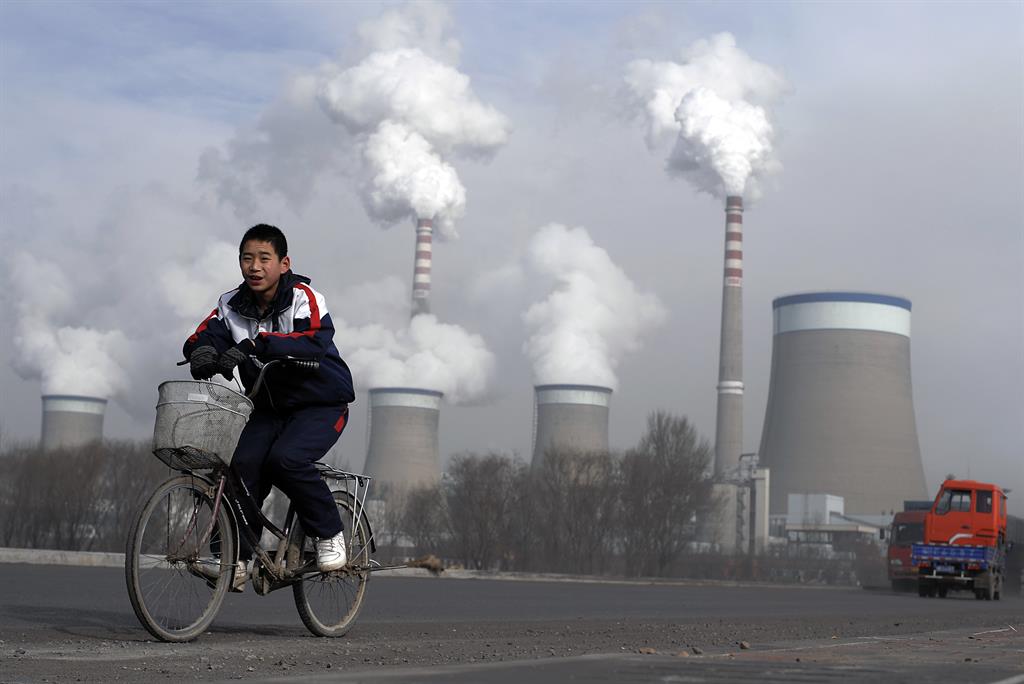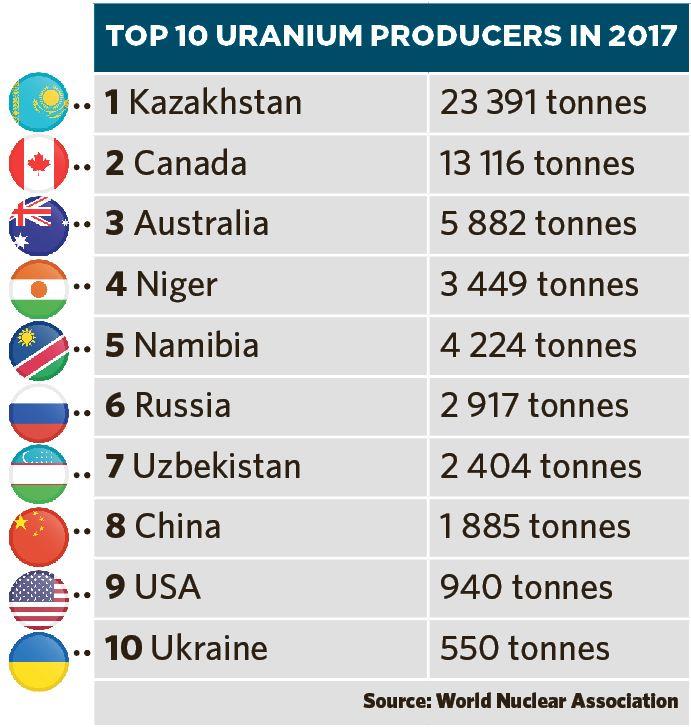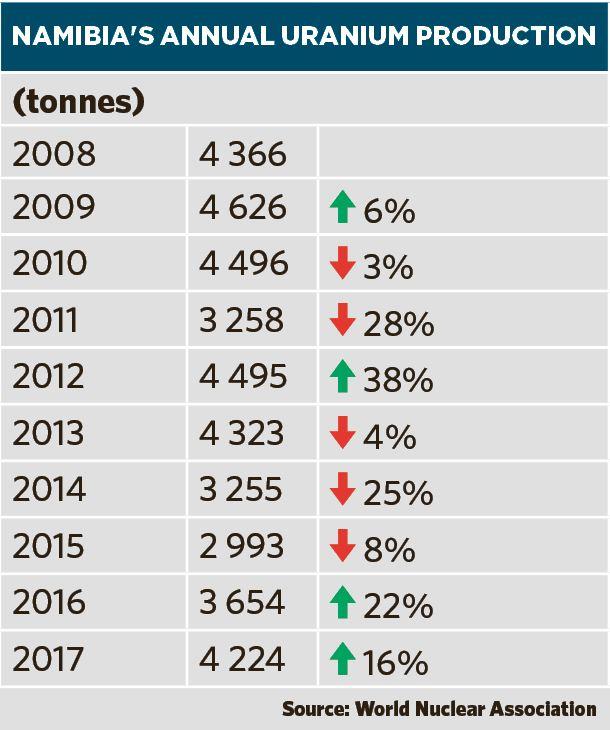Namibia flexes uranium muscles
According to the World Nuclear Association, Namibia was the world’s fourth biggest uranium producer last year.
Jo-Maré Duddy – Namibia last year contributed about 7.1% to the total global production of uranium, up from near 5.9% in 2016.
The latest figures published on the website of the World Nuclear Association (WNA) show Namibia produced 4 224 tonnes of uranium in 2017, up 570 tonnes or nearly 15.6% from the previous year.
As such the country, as in 2016, was the fourth biggest uranium producer in the world.
Only two countries in the list of the top 10 producers last year delivered more uranium than in 2016: Namibia and China. China’s production rose by nearly 16.7% to 1 885 tonnes.
The WNA stats date back to 2008. According to this, Namibia held the spot as the world fourth biggest producer from 2008 to 2010. From 2011 to 2014, it was the fifth biggest, before sinking to the sixth spot in 2015.
Namibia’s production last year was the highest since 2013, when 4 323 tonnes were delivered. 2013 was the last year Trekkopje contributed to production.
Mines
Rössing Uranium delivered the bulk of local uranium production in 2017, according to the WNA. The mine delivered 1 790 tonnes of uranium, up 221 tonnes or about 14% compared to 2016. Rössing’s production in 2017 was the highest since 2013 when the mine deliver 2 043 tonnes.
Langer Heinrich’s production in 2017 was 1 308 tonnes, according to the WNA. This is 585 tonnes or nearly 31% less than the previous year and the mine’s lowest production since 2009. Low uranium prices forced Paladin Energy, who owns 75% of Langer Heinrich, to review and cut it production plan in November 2016. In April this year, Paladin decided to halt production at the mine and put it on care and maintenance.
Although the WNA doesn’t state production at Husab, its figures imply that Namibia’s new mine produced about 1 134 tonnes of uranium in 2017.
The WNA’s production figures differ from those contained in the 2017 Annual Review of the Chamber of Mines of Namibia. According to the Chamber, Rössing produced 2 110 tonnes in 2017, while Langer Heinrich delivered 1 526 tonnes and Husab 1 345 tonnes. That brings total production to 4 981 tonnes, which still places Namibia as the world’s fourth biggest uranium producer in 2017.
On the WNA’s website, updated in May this year, it states that Namibia has “two significant uranium mines capable of providing 10% of world mining output”. The impact of Langer Heinrich’s care and maintenance wasn’t taking into consideration with this statement. However, the WNA adds that a “larger mine [Husab] is coming into production”.
Economic impact
The 2017 Annual Accounts by the Namibia Statistics Agency (NSA) show that, at current prices, uranium contributed about N$1.2 billion to the country’s gross domestic product (GDP) last year. As such, it contributed 0.7% to the GDP.
At constant 2010 prices, which take inflation into account, uranium mining grew by 23.4% in 2017, up from 13.6% in 2016 and the highest growth since 2008 when it was 30.1%.
At constant 2010 prices, uranium contributed about 1.5% to GDP last year, compared to 1.2% in 2016.
According to the Bank of Namibia’s (BoN) latest Economic Outlook, released in July, uranium mining is expected to grow by only 7.5% in 2018. Growth is forecast to recover to 15.6% next year and increase to 20.1% in 2020.
China
Both China and India are interested in acquiring uranium from Namibia, the WNA says. “Chinese companies have taken major equity positions, notably with Husab, but also Langer Heinrich.”
Chinese Overseas Uranium Holdings Ltd has a stake of 25% in Langer Heinrich, while China General Nuclear Power Holding Company and the China-Africa Development Fund own 90% of Husab.
According to the WNA, Mainland China has over 40 nuclear power reactors in operation, about 20 under construction, and more about to start construction.
The Chinese government's long-term target, as outlined in its Energy Development Strategy Action Plan 2014-2020, is for 58 GWe capacity by 2020, with 30 GWe more under construction, the WNA states.
The WNA says “India is discussing how to open the way to be able to buy Namibian uranium, at present ruled out by Namibia’s non-proliferation commitments”.
Namibia has ratified the 1996 African Nuclear Weapon Free Zone Treaty, also known as the Pelindaba Treaty, which came into force in 2009 and precludes export of uranium to India.
The latest figures published on the website of the World Nuclear Association (WNA) show Namibia produced 4 224 tonnes of uranium in 2017, up 570 tonnes or nearly 15.6% from the previous year.
As such the country, as in 2016, was the fourth biggest uranium producer in the world.
Only two countries in the list of the top 10 producers last year delivered more uranium than in 2016: Namibia and China. China’s production rose by nearly 16.7% to 1 885 tonnes.
The WNA stats date back to 2008. According to this, Namibia held the spot as the world fourth biggest producer from 2008 to 2010. From 2011 to 2014, it was the fifth biggest, before sinking to the sixth spot in 2015.
Namibia’s production last year was the highest since 2013, when 4 323 tonnes were delivered. 2013 was the last year Trekkopje contributed to production.
Mines
Rössing Uranium delivered the bulk of local uranium production in 2017, according to the WNA. The mine delivered 1 790 tonnes of uranium, up 221 tonnes or about 14% compared to 2016. Rössing’s production in 2017 was the highest since 2013 when the mine deliver 2 043 tonnes.
Langer Heinrich’s production in 2017 was 1 308 tonnes, according to the WNA. This is 585 tonnes or nearly 31% less than the previous year and the mine’s lowest production since 2009. Low uranium prices forced Paladin Energy, who owns 75% of Langer Heinrich, to review and cut it production plan in November 2016. In April this year, Paladin decided to halt production at the mine and put it on care and maintenance.
Although the WNA doesn’t state production at Husab, its figures imply that Namibia’s new mine produced about 1 134 tonnes of uranium in 2017.
The WNA’s production figures differ from those contained in the 2017 Annual Review of the Chamber of Mines of Namibia. According to the Chamber, Rössing produced 2 110 tonnes in 2017, while Langer Heinrich delivered 1 526 tonnes and Husab 1 345 tonnes. That brings total production to 4 981 tonnes, which still places Namibia as the world’s fourth biggest uranium producer in 2017.
On the WNA’s website, updated in May this year, it states that Namibia has “two significant uranium mines capable of providing 10% of world mining output”. The impact of Langer Heinrich’s care and maintenance wasn’t taking into consideration with this statement. However, the WNA adds that a “larger mine [Husab] is coming into production”.
Economic impact
The 2017 Annual Accounts by the Namibia Statistics Agency (NSA) show that, at current prices, uranium contributed about N$1.2 billion to the country’s gross domestic product (GDP) last year. As such, it contributed 0.7% to the GDP.
At constant 2010 prices, which take inflation into account, uranium mining grew by 23.4% in 2017, up from 13.6% in 2016 and the highest growth since 2008 when it was 30.1%.
At constant 2010 prices, uranium contributed about 1.5% to GDP last year, compared to 1.2% in 2016.
According to the Bank of Namibia’s (BoN) latest Economic Outlook, released in July, uranium mining is expected to grow by only 7.5% in 2018. Growth is forecast to recover to 15.6% next year and increase to 20.1% in 2020.
China
Both China and India are interested in acquiring uranium from Namibia, the WNA says. “Chinese companies have taken major equity positions, notably with Husab, but also Langer Heinrich.”
Chinese Overseas Uranium Holdings Ltd has a stake of 25% in Langer Heinrich, while China General Nuclear Power Holding Company and the China-Africa Development Fund own 90% of Husab.
According to the WNA, Mainland China has over 40 nuclear power reactors in operation, about 20 under construction, and more about to start construction.
The Chinese government's long-term target, as outlined in its Energy Development Strategy Action Plan 2014-2020, is for 58 GWe capacity by 2020, with 30 GWe more under construction, the WNA states.
The WNA says “India is discussing how to open the way to be able to buy Namibian uranium, at present ruled out by Namibia’s non-proliferation commitments”.
Namibia has ratified the 1996 African Nuclear Weapon Free Zone Treaty, also known as the Pelindaba Treaty, which came into force in 2009 and precludes export of uranium to India.









Comments
Namibian Sun
No comments have been left on this article